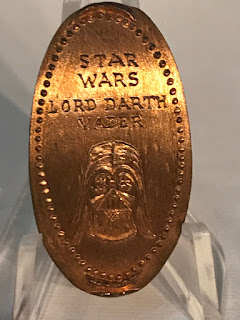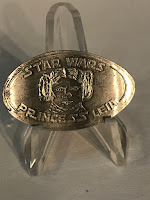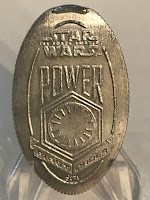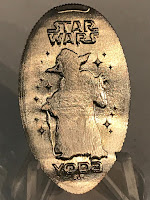Steve writes:
Resident guest blogger and master of the Star Wars eclectic Yehuda Kleinman is back with an extensive look at a collecting niche with roots dating all the way back to 1893 that continues to live on today.
Pressed pennies, squished cents or elongated coins are the names given to kitschy souvenirs that can be self-manufactured by a tourist or visitor at a locale with nothing more than pocket change and occasionally some elbow grease on a classic hand-cranked machine.
The different machines that create these collectibles can be manual or automatic but all follow the same basic principle: transforming standard round pocket currency into oval flattened souvenirs with embossed images of interest, often commemorating the activity or place where the machine is located, or at times depicting an individual or character.
A coin of a particular currency that the machine accepts for transformation (most often a penny) is inserted into a slot, and for a small fee the machine is activated. With the use of a manual hand-crank or through electronic motorized gears, the coin travels through a labyrinth of machinery until it reaches a round die with an often intricate design which then sandwiches the coin between a second metal surface, usually obliterating the original coin image and replacing it with a completely new design on a now flattened ovoid souvenir.
Classic hand-cranked pressed penny machine and mechanism.
The prehistoric origin of saving a flattened coin as a souvenir dates back to the 19th century and all began with trolley cars. It was commonplace for truant children or quirky tourists to place a coin on the trolley tracks and wait for the trolley to pass over the coin. This would result in a flattened piece of metal with loss of its detail that could be carried around as a symbol of stupidity.
The first elongated coin machine with an embossed design was created for use at the 1893 World's Fair in Chicago. It was manufactured and functioned in the same way that modern hand-crank machines do. The difference is that at the time, the machine was operated by an attendant (likely wearing a 3-piece suit).
 |
| The first known pressed penny. |
The pressed penny machine was a tremendous success at the 1893 Chicago World's Fair. Not only did people enjoy having an inexpensive souvenir customized to the event, they were able to watch with glee as the souvenir was created, much like their easily amused ancestors did staring at the trolley tracks just a few years before.
The popular introduction of pressed pennies at the World's Fair spawned a new tradition of creating unique pressed penny machines with custom designs commemorating each different event. Machines also started popping up at local points of interest. People began to develop collections of these pressed pennies as keepsakes of their travels and from there a collecting hobby was born.
Well over a century later, pressed pennies continue to be a popular collectible for many of the same reasons. They remain detailed interesting collectibles that are inexpensive and have the added enjoyment of being manufactured by the collector when using a hand-cranked machine.
Below is some general information about collecting pressed coins and suggested preferences for choosing a coin to press when possible.
When pressing a penny, typically a solid copper coin is preferred. In the United States, pennies that were manufactured prior to the year 1982 were 95% copper and are often preferred for pressing. After 1982, pennies are composed of 97.5% zinc plated with copper. The solid copper coins give a uniform appearance to the final pressed coin. On the other hand, zinc pennies with a copper plating will often show the white zinc metal streaking throughout the copper plating once the coin is pressed, often obscuring the design. (It should be noted that pennies dated 1982 can either be copper or zinc as the mints were transitioning.)
Pictured above is an example of a pressed penny using a solid copper coin and the same pattern pressed on a copper plated zinc coin which demonstrates zinc streaking.
Hand-cranked machines offer the operator the ability to choose which coin is to be pressed, while automatic machines will usually supply the coin to be pressed (typically a new copper plated zinc penny). On the plus side, the zinc and copper pennies supplied by an automatic pressed penny machine do not typically express streaking since the coin dies on the automatic machines are designed to make a more shallow relief and do not break the copper plating when operating correctly.
Although pennies are the most common coin to be used for pressing, nearly every type of denomination has been used. Some dies are manufactured for use on specific types of coins, while other dies can be used on multiple types of coins by altering the coin slot. Poor condition silver coins from the United States minted prior to 1965 and steel pennies from 1943 will occasionally be used as souvenirs or for a special occasion.
 |
| A The Force Awakens "Rey" coin pressed on a 1964 silver quarter. |
Coins that are selected for pressing are often cleaned with different methods prior to pressing. For the best results, a common method is to clean the coins with ketchup. Coins are sometimes sealed with wax afterwards to prevent tarnishing.
Pressed pennies can either be manufactured with licensed or unlicensed images. Once a machine is no longer in use, the pressed coin is considered "retired." Coin dies should ideally be altered in a way to indicate that any new coins produced by the dies have been produced after retirement.
Pressed coins that have licensed images are usually retired at a specific point and the coin dies are not frequently used again unless they are marked after retirement. This is typically the case for pressed coins made at Disney locations. At present, Disney is the largest producer of pressed coins.
Coins produced with unlicensed images (or bootleg coins) which are in private hands are often retired when they are taken out of use and destroyed because of lack of interest. However, some bootleg coin dies have been used for decades, making their products readily available.
Disney has been manufacturing pressed coins since 1987 and has exponentially increased the interest in the hobby. Some pressed coins can be quite challenging to find likely because they were individually manufactured by tourists and collectors as needed without any overstock. Disney parks will regularly offer many new unique coin presses at different times throughout the year at their resorts. They will also routinely retire pressed coins throughout the year. Disney retires their dies by marking each engraved image with a small additional animated engraving, often of Tinker Bell. The result is that any future use of the dies will cause a new pressed image to form the new added included image of Tinker Bell indicating that the coin is a re-strike.
M&M Minis come in a tube which is a favorite piece of hobby equipment for many pressed penny enthusiasts. The tubes are used as storage containers for quarters and pennies. A typical pressed penny cost two quarters and one penny. The $.50 is used for the price of using the machine and the penny itself is selected for pressing. The tube is filled by placing two quarters in the bottom followed by a penny followed again by two quarters and another penny until the tube is filled with pre-prepared clean copper pennies and quarters.
 Pressed coin collecting is considered a category of coin collecting and in numismatic circle falls under the subtitle "exonumia," which includes collecting tokens. Retired pressed coins can often be found at coin collector sites and stores as well as through pressed coin collector clubs and online auction sites.
Pressed coin collecting is considered a category of coin collecting and in numismatic circle falls under the subtitle "exonumia," which includes collecting tokens. Retired pressed coins can often be found at coin collector sites and stores as well as through pressed coin collector clubs and online auction sites.Vintage pressed coins are often found with a drill hole at the top of the coin. These drill holes were placed so the coin could be worn on a chain or charm bracelet.
A pressed penny featuring R2 and 3PO which was previously used on a charm bracelet.
Throughout the years, people have collected pressed coins in different ways. While some collectors continue to restrict their collection to coins that they were able to manufacture themselves, many collectors focus on assembling a cohesive collection, often on a specific genre.
Pressed pennies are often kept in an album for display and storage.
This article will focus on all of the known pressed coins that have a Star Wars theme. Pressed coins are often available in themed sets from the same pressed coin machine. When pressed coins are known to be part of a set, the information will be included. A notation will be made if the coin has a licensed or unlicensed image. The coins will also be categorized in three groups.
Category 1: Coins that are still in production and are readily available.
Category 2: Coins that are retired but are still often available on secondary markets or coins that are not yet retired but have poorly accessible machines.
Category 3: Retired coins with small production numbers often with bootleg images.
The earliest known Star Wars pressed coins are a set of 4 pressed pennies which were likely available in the 80s. They are unlicensed. Only copper examples are known. (Retired)
1980s Rebel DX-2 Star Sprite with X-Wing Bootleg Imagery (Retired). 1982 Zinc plated example with streaking evident.
 |
| 1980s Imperial Ice Probe Photon KZ66 with Probot Bootleg Imagery (Retired) |
 |
| 1980s Robot World Exploratory Wisconsin Dells with Image of Bootleg C-3PO “Robot” (Retired) |
The coin above was available at the Robot World Exploratory in Wisconsin. The robot depicted was clearly modeled after C-3PO and gave a guided tour of the tourist attraction.
This following set is comprised of 12 different designs which have shown up over the years on nearly every denomination. The set consists of portraits and scenes from the Original Trilogy as well as from The Phantom Menace. The coins have been found on pennies, nickels, dimes, and quarters. Curiously, they have also been found embossed on pennies but not flattened or elongated and then subsequently coated with a white metal. Coins with these designs have been found since the early 2000s but also have been found on more recently minted coins. These are bootleg designs and it is unclear if the coins are retired.
2000s Bootleg Set
2000s Bootleg Set Pressed on Nickels
2000s Bootleg Darth Maul Pressed on Penny, Nickel, Dime, and Quarter
2000s Bootleg Designs Pressed into Pennies (Non-flattened, Non-elongated; coated in white metal)
The Disney Corporation embraced pressed coins in 1986 as a new staple of the Disney Park experience and has since progressively filled their properties with hundreds of pressed coin machines worldwide. The following year in 1987, Disney opened it first attraction featuring a non-Disney property: Star Wars. Popularity in the Star Wars franchise had been waning in the mid-1980s. It had been 3 years since the release of the last expected chapter of the Original Trilogy in Return of the Jedi and there were no new films on the horizon. However, Disney recognized the legacy of George Lucas’ creation and understood its staying power.
Star Tours -- a virtual reality ride simulating varied space adventures while on board the exclusive Disney space shuttle (the StarSpeeder 3000) -- was originally launched at the Disneyland park. The ride was subsequently introduced at 3 other Disney parks: Disneyland Hong Kong, Hollywood Studios-Orlando, and Disneyland Paris. The first Disney pressed coin with Star Wars imagery was a penny featuring an astronaut Mickey Mouse and a StarSpeeder 3000. The combination of Star Wars imagery married with classic Disney characters was a consistent feature in the early Disney coins.
 |
| 1st Disney Star Tours Coin (Retired 2002) |
The second coin Disney produced was available in Disneyland for only one year. It was part of the "Magical Milestones" series of coins that were made to celebrate the 50th Anniversary year of the park in 2005. Each coin in the set was made to commemorate a specific event from each of the 50 years of the park's history. The coin design produced to represent 1987 was made in honor of the inauguration of the Star Tours ride. It once again represented the StarSpeeder 3000, now gliding in front of the Death Star. This is the first Star Wars pressed coin to display a new image on both sides of the coin. The reverse features the Magical Milestones logo found on all of the coins in the set.
"Magical Milestones" Star Tours Coin (Retired 2006)
In October of 2012, the Disney Corporation acquired Lucasfilm, including the ownership and rights to the Star Wars franchise. It was at this point that Disney decided that it would be a better approach to minimize melding the classic Disney characters with Star Wars characters as was their practice on many products up until this point. The idea was that as the new steward of the franchise, Disney hoped to maintain Star Wars souvenirs and merchandise more true to the Star Wars universe.
Before these changes could be implemented, a new set of 3 Star Tours pressed pennies were released in early 2013. These coins featured the Star Tours logo with classic Disney characters mashed up with Star Wars characters. The coins feature a Goofy/Darth Vader, a Mickey Mouse/Luke Skywalker, and a Minnie Mouse/Princess Leia.
Star Tours Disney Mash-ups (Retired 2016)
In 2016, the 3 Star Wars/Disney mash-up coins were retired and replaced with a new set of 3 coins featuring R2-D2, Yoda, and a third new character Kylo Ren from the then recently released Star Wars film The Force Awakens. These were the first Disney pressed coins true to the company's new philosophy: designed with accurate Star Wars character portrayals without the addition of classic Disney elements.
Star Wars Disney Coins (2016)
Between 2016-2017 Disney has produced an additional 4 sets of 8 pressed pennies. Each set is produced by an automatic machine with supplied copper plated zinc pennies. The 4 machines are located at different attractions throughout the Disney parks in Orlando, Florida. These sets have characters and imagery from the original films as well as characters and imagery from the newer films produced by Disney.
This set depicts images from The Force Awakens and they can be pressed at the Launch Bay attraction at the Hollywood Studios theme park.
The Star Wars Galactic Outpost in Disney Springs is a store dedicated to collectibles and souvenirs from a galaxy far, far away. It boasts an 8-penny Star Wars pressed penny machine with action posed characters and ships from The Force Awakens.
This next set of 8 coins is from the Epcot store Mouse Gear. It features character portraits from the Original Trilogy. They are also numbered 1-8 (this machine was originally located in Disney Springs at the Once Upon a Toy store).
The following fourth set of 8 pennies can be found in the Magic Kingdom at Disney World.
The Disneyland Resort in Anaheim, California offers 4 sets of 3 Star Wars pressed quarters which are all double sided. The first two sets are located in Disneyland. Each set is pressed in a different machine and portrays imagery from The Force Awakens. One set features heroes while the other features villains.
The other two sets are pressed at the California Adventure park and feature characters from
the Original Trilogy in a set of silhouettes and a set of line drawings amidst a starry background.
A new set of pressed coins was produced in honor of Disneyland's 60th Anniversary, just as Disney had done previously to mark the park’s 50th Anniversary. The coins were double sided and featured imagery that represented important chapters in the park's history. Included was a penny with an image of C-3PO emblazoned on its front.
Pressed coins are now an international affair with unique examples from all over the world. Just like their American predecessors, the international sets are pressed to commemorate an event or a visit to a tourist destination. The country of origin and other known information for each set will be noted.
This set of 3 pressed coins are from Disneyland Hong Kong and feature intricately designed images from The Force Awakens.
These 4 pressed coins are a Star Tours set from Tokyo Disneyland and feature the Star Tours logo and emblem. One of the coins depicts a StarSpeeder 3000 while the other three feature Original Trilogy characters.
The next 3 pressed coins are part of a traveling prop exhibition called “Star Wars Identities." They display some of the most interesting and detailed art found on a pressed coin. The exhibit has 3 intricate portraits which have been reproduced in great detail on pressed pennies. The exhibit coins includes a portrait of Darth Vader with his bust composed of an active Death Star in battle, including TIE Fighter ships in flight. A second portrait shows a bust of the Jedi Master Yoda composed of a landscape of his home planet of Dagobah. A Stormtrooper helmet composed of hundreds of tiny Stormtroopers makes up the third portrait. The exhibit has been throughout Canada, France, and England thus far.
These 4 teardrop shaped pressed coins originate from London. They are double sided and are from Madame Tussaud's Wax Museum.
The Shanghai Disney resort which first opened in 2016 offers these 4 pressed pennies, including a Boba Fett.
Finally, these 6 coins feature characters from The Force Awakens and Original Trilogy, and are likely from Taiwan. More information is needed about this set. They appear to be licensed and may have been available at an event.




































































































































Wow, never knew about these. Cool to read about.
ReplyDeleteGreat article. Thank you.
ReplyDeleteGreat article! Thank you very much for posting it!
ReplyDelete